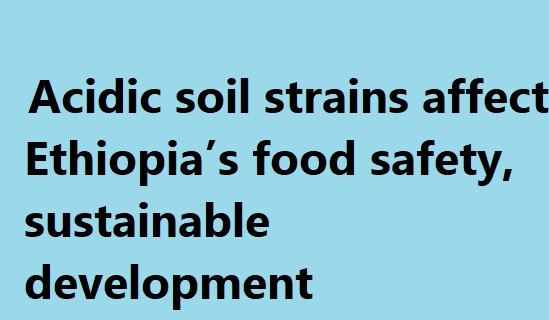
Agriculture plays a vital role in the country’s economy, employing a significant portion of its population and contributing to food security. Soil is the primary agricultural setting for a country that was founded on agriculture. However, beneath its fertile soils lies a hidden challenge that has been silently affecting the agricultural productivity of the country.
The acidity of soil is a critical factor that influences the growth and development of plants. While some soils naturally possess acidic properties, others become acidic due to various factors, including human activities and environmental processes.
In Ethiopia, the issue of acidic soil has gained prominence as it poses a significant hazard to sustainable agriculture and food production.
There are many causes of acidic soil in Ethiopia. Such factors as natural weathering processes, deforestation, improper land management practices, and the use of certain fertilizers contribute to the acidification of soil.
The existence of acidic soil in Ethiopia has several consequences that impact agricultural productivity and the overall well-being of farmers.
Based on the research, Acidic soil limits the availability of essential nutrients to plants. It hinders the uptake of nutrients such as phosphorus, calcium, etc., which are crucial for healthy plant growth. Consequently, crops grown in acidic soil suffer from nutrient deficiencies, leading to stunted growth, low yields, and inferior crop quality.
Not only reducing but also increasing soil toxicity elements like aluminum and manganese. These elements become more available to plants, causing toxicity symptoms and impairing their growth and productivity. Moreover, the increased solubility of heavy metals can pose environmental risks, potentially contaminating water sources and affecting human and animal health.
Acidic soil negatively affects the activity and diversity of beneficial soil microorganisms. That can disrupt microbial balance, leading to a decline in soil fertility and ecosystem functions.
The combined effects of nutrient deficiencies, toxicity, and impaired soil microbial activity contribute to reduced crop yields in acidic soil. Farmers face significant challenges in achieving the desired productivity levels. This phenomenon not only threatens the livelihoods of smallholder farmers but also poses challenges to achieving food security and sustainable development goals in the country.
The challenge of making acidic soil produce by treating it with natural fertilizers has been completed, according to the agricultural ministry, and the work of reducing the acidity of the soil is being done to boost production and productivity in the nation.
Soil resource development’s leading executive at the Ministry of Agriculture, Lire Abiyu, told to Ethiopia Press Agency “Over 6.4 million hectares of land were treated in the current fiscal year as part of the work to improve soil fertility by preparing natural fertilizers.”
According to him, the situation of being affected by acidity, the growth of salty soil, and the issue of waterlogging in acidic soil are the challenges that are growing in Ethiopia’s soil fertility and health.
Based on him, Ethiopia’s seven million hectares of acidic land are being worked on to boost productivity and production; he also explained that agricultural lime grinding mills in Dejen town of Amhara State, Guder town of Oromia State and Kela Woreda of the Gurage zone are used to reduce soil acidity.
He further stated that while 8,671 hectares of land were treated with agricultural lime the performance was inadequate due to supply issues and other challenges.
Areas with a lot of rainfall are highly vulnerable for acidification. One of them, for instance, is Southwest Ethiopia, where efforts are being made to grow coffee and tea plants that can withstand the issue.
Aside from this, he said, acidity can be avoided by growing sorghum and oat crops. He stated that it had completed the work on more than 655 thousand hectares of land necessary to make soil suitable for farming.
To address the issue of acidic soil effectively liming helps restore the optimal pH range for plant growth, enhances nutrient availability, and improves soil structure. The amount of lime required varies depending on the severity of soil acidity and the specific crop requirements.
He noted that we are testing the location of lime minerals in collaboration with the Ministry of Mines and providing attention to the supply of lime as they begin production activities.
In addition to allowing farmers to use natural fertilizers extensively in the 2016 year, it is also intended to make lime available to farmers for use as fertilizer. Moreover, he further stated that 5.5 million hectares of land will be covered in natural fertilizers, 700,000 hectares would be covered with acidic soil, and 10,000 hectares of acidic soil would receive treatment in the coming year.
He said that by maintaining the land fertile and healthy, it is possible to double productivity in addition to what is already being done to solve the issue.
Besides this, Incorporating organic matter into the soil, such as compost, manure, or cover crops, helps improve soil structure and enhances nutrient-holding capacity. Organic matter buffers soil acidity and promotes beneficial microbial activity, contributing to long-term soil health and fertility.
Properly balanced and targeted fertilization is essential for managing acidic soils. Soil testing can guide the application of fertilizers that address specific nutrient deficiencies. Using slow-release fertilizers and avoiding excessive use of acidic fertilizers can help prevent further soil acidification.
Furthermore, implementing conservation agriculture techniques, such as contour plowing, terracing, and agroforestry, helps reduce soil erosion and maintain soil organic matter content. These practices contribute to overall soil health and resilience, mitigating the impacts of acidity.
And also, promoting farmer education and extension services is crucial for disseminating knowledge about soil management practices, such as liming, adopting sustainable land management practices, promoting agroforestry, and utilizing appropriate fertilizers. Additionally, policymakers, researchers, and other concerned parties must explore the importance of capacity-building programs and knowledge dissemination to empower farmers with the necessary tools and techniques to combat acidic soils.
Addressing the issue of acidic soil in Ethiopia requires a holistic and integrated approach that combines scientific knowledge, local expertise, and community engagement. By adopting sustainable soil management practices and implementing targeted interventions, Ethiopia can mitigate the negative impacts of acidic soil and pave the way for improved agricultural productivity, food security, and sustainable development.
BY FIKADU BELAY
THE ETHIOPIAN HERALD SUNDAY 10 SEPTEMBER 2023





